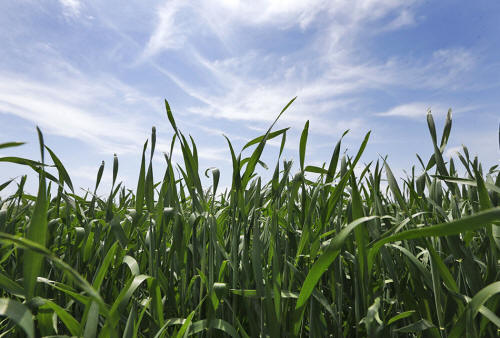|

by Taylor Dolven
May 08, 2015
from
VICE Website

The world's population is projected to reach nine billion by 2050
- and that's putting extraordinary pressures on the agricultural
sector, especially as climate change is expected to wither many
productive areas around the world, while submerging others during
increasingly frequent floods.
Echoing the mantra of the 1960s Green Revolution, many nations - and
big agricultural interests - say chemical fertilizers and
high-yield, industrial-scale farming operations are the 'logical'
response to this daunting task of producing more food under
increasingly harsh environmental conditions.
Going against grain, though, are proponents of
agroecology, which emphasizes
growing many crops simultaneously, on smaller plots of
land, without expensive chemistry.
Rather than fertilizers, proponents of
the practice use cover crops, such as,
...to enrich their fields.
And, instead of pesticides, they
cultivate flowers and trees in order to attract insects that prey
upon the bugs that might jeopardize their harvests.
While industrial agriculture has helped to boost yields, Albie
Miles, an assistant professor at the University of Hawaii, said
air, water, and soil quality, as well as human health, has been
compromised.
"We are pursuing an industrial model
of agriculture full throttle, which not only contributes
significantly to global climate change, but poses risks to human
health and biodiversity while undermining the natural resource
base upon which agriculture and food security depends," Miles
said.
As the global population expands and
begins to feel the pinch
of climate change, agroecologists
believe that traditional forms of farming offer a bounty of
solutions to the most seemingly vexing problems associated with food
production.
"We have much to learn from
traditional agricultural practitioners," said Miles.
"We are in the face of global
climate change, we need to fundamentally rethink our food and
energy production, and make a transition to an ecologically
based form of agriculture."
As much as 12 percent of global
greenhouse gas emissions come as a result of the world's tilling,
planting, and harvesting according to the UN Intergovernmental
Panel on Climate Change.
Not all agriculture systems are the
same, though.
In its latest report the climate agency
noted that agroecological techniques reduce greenhouse gas
emissions, as well as boost output.
"A range of agro-ecological options
to improve agricultural practices… have potential to increase
yields, while also providing a range of co-benefits such as
increased soil organic matter," the report said.
Agroecological systems, said Miles, are
more practical for developing countries and rural areas because
genetically engineered seeds and
pesticides are often too expensive.
And, he added, localized food systems
are more resilient because they shorten supply-chains.
Anna Jones-Crabtree and her husband Doug consider
themselves a large-scale, financially successful model for
agroecology, growing 21 different varieties of food on 4,700 acres
in Northern Hill County, Montana.
"If we really want to have a
different form of agriculture we have to get off the drugs," she
told VICE News. "We want to be a model that shows that there's a
different way to farm."
Regardless of her biases toward
organics, Jones-Crabtree said she and her husband wouldn't have been
able to start an industrial-scale farm because of the high cost of
genetically modified seeds and chemical-enriched pesticides and
fertilizers.
Seen from the air, their farm reveals other characteristics that
differentiate agroecology practices from industrial agriculture.
Twenty percent of their pastures are
non-crop conservation land, areas set aside for those trees and
flowers that might help fight off infestation. In contrast to that
diversity of flora, a typical agricultural operation grows acre upon
acre of the same crop.
While
Vilicus Farms demonstrates the
potential for alternatives to industrial agriculture, agroecology
boosters face an uphill battle when seeking to scale up their
methods, primarily due to a lack of institutional support.
And that's a situation that the University of Hawaii's Miles is
trying to change.
In a recent study (Closing
the Knowledge Gap - How the USDA could Tap the Potential of
Biologically Diversified Farming Systems) of US
Department of Agriculture research funding, Miles and his colleagues
found that less than 2 percent of
USDA Research, Education, and
Extension funding went toward developing and supporting certified
organic agriculture in 2012.
Now they are conducting a comprehensive
analysis of USDA funding for agroecology, but they believe it to be
similarly low.
"There's a very clear track, but the
entire field has been marginalized," Miles told VICE News.
"I think as we start to face further
and further environmental degradation, agriculture will have to
come to the floor. This is the biggest story to be told right
now."
|


